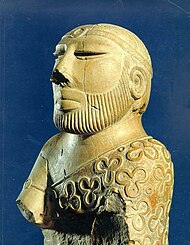Soomra dynasty
Soomra dynasty | |||||||||
|---|---|---|---|---|---|---|---|---|---|
| 1026–1351 (Continued in exile until 1440 inUmerkot) | |||||||||
| Status | Vassals of theAbbasid Caliphate(1026-1351)[1] | ||||||||
| Capital | Thari (in present-dayBadin DistrictinSindh) | ||||||||
| Common languages | Sindhi(native language) Arabic(liturgical language) | ||||||||
| Religion | ShiaIsmaili | ||||||||
| Government | Monarchy | ||||||||
| History | |||||||||
• Soomra dynasty begins | 1026 | ||||||||
• Soomra dynasty ends | 1351 (Continued in exile until 1440 inUmerkot) | ||||||||
| |||||||||
| Today part of | Sindh | ||||||||
| History ofPakistan |
|---|
 |
| Timeline |
TheSoomra dynastywas a late medieval dynasty ofSindhruled by theSoomrotribeofSindh,and at times adjacent regions, located in what is nowPakistan.[2]
Sources
The only extant source is theDiwan-i Farruhi,a Persian chronicle by Abul-Hasan Ali describingMahmud of Ghazni's invasion (1025 AD) ofMansura,the erstwhile capital of Sindh.[3]Contemporary coinage from Sindh is scarce and of poor quality with offset flans — while some of them can be read to contain the name ofAl-Zahir li-i'zaz Din AllahandAl-Mustansir Billah,the Fatimid Caliphs from 1021 until 1094, then, they lack in the name of the issuer and cannot evidence the dynasty.[4]
History
Establishment
The early history of Soomras is unclear. Ali describes the flight and eventual death by drowning of Hafif (var. Khafif), then-ruler of Sindh, during the faceoff with Mahmud but does not specify whether he was the last Habbarid or first Soomra.[3][a]Later chroniclers likeAli ibn al-Athir(c. late 12th c.) andIbn Khaldun(c. late 14th c.) attributed the fall of Habbarids to Mahmud of Ghazni, lending credence to the argument of Hafif being the last Habbarid.[3]The Soomras appear to have established themselves as a regional power in this vacuum.[3][5]
In an oldBalochiballad,Dodo Soomra IV is mentioned as aJaghdal(Balochi term forJat), marrying abalochwoman. From him, theDodaiclan of Balochs claim descent.[6][7]Tabakat-i-Akbari(16th cen.) mentions Soomras as aJattribe.[8]
The Soomras themselves also claimed anAraborigin.[9][10]
They have been retrospectively claimed to beParmar Rajputs.[11]InAin I Akbari(16th century) the Sumra dynesty is mentioned as of ARajputleneage.[12]Some of them were adherents ofIsma'ilism— Arab travelers held them to beQarmatians,and correspondence with the Fatimid caliph,Al-Mustansir Billahhas been located.[5]
Territory
TheGhuridsandGhaznavidscontinued to rule parts of Sindh, across the eleventh and early twelfth century, alongside Soomras.[3]The precise delineations have yet to be discovered, but the Soomras were probably centered in lower Sindh.[3]One of their kings Shimuddin Chamisar had submitted toIltutmish,theSultan of Delhi,and was allowed to continue as a vassal.[13]
See also
Notes
- ^C. 1105, Isma'ilis of Multan had sought refuge in Masura during Ghazni's invasion of the city and reasons for his campaign(s) against Hafif are noted to be the flourishing river trade of Isma'ilis and his (Hafif's) alliance with Jats.
References
- ^Stanton, Andrea (2012).Cultural Sociology of the Middle East, Asia, & Africa, Volume 4.SAGE Publications. p. 110.ISBN978-1-4129-8176-7.
- ^"The Arab Conquest".International Journal of Dravidian Linguistics.36(1): 91. 2007.
The Soomras are believed to be Parmar Rajputs found even today in Rajasthan, Saurashtra, Kutch and Sindh. The Cambridge History of India refers to the Soomras as "a Rajput dynasty the later members of which accepted Islam" (p. 54 ).
- ^abcdefCollinet, Annabelle (2008). "Chronology of Sehwan Sharif through Ceramics (The Islamic Period)". In Boivin, Michel (ed.).Sindh through history and representations: French contributions to Sindhi studies.Karachi: Oxford University Press. pp. 9, 11, 113 (note 43).ISBN978-0-19-547503-6.
- ^Fishman, A. M.; Todd, I. J. (2018). "Uncertain Late Habbarid and Soomra Sindh ca. 1000-50 CE".The silver damma: on the mashas, daniqs, qanhari dirhams and other diminutive coins of India, 600-1100 CE.Mumbai, India: IIRNS Publications. pp. 176–184.ISBN978-81-938291-0-3.OCLC1097788735.
- ^abBoivin, Michel (2008). "Shivaite Cults And Sufi Centres: A Reappraisal Of The Medieval Legacy In Sindh". In Boivin, Michel (ed.).Sindh through history and representations: French contributions to Sindhi studies.Karachi: Oxford University Press. p. 30.ISBN978-0-19-547503-6.
- ^Kothiyal, Tanuja (14 March 2016).Nomadic Narratives: A History of Mobility and Identity in the Great Indian Desert.Cambridge University Press.ISBN978-1-107-08031-7.
- ^Dames, Mansel Longworth (1904).The Baloch Race: A Historical and Ethnological Sketch.Royal Asiatic Society.
- ^Watson, John Whaley (1886).History of Gujarat, Musalman Period, A.D. 1297-1760.Printed at the Government Central Press.
- ^Wink, André (2002).Al-Hind, the Making of the Indo-Islamic World: Early Medieval India and the Expansion of Islam 7Th-11th Centuries.BRILL. p. 166.ISBN978-0-391-04173-8.
The Sumras were a dynasty of local origin, later claiming to be Rajputs as well as Arabs, and are clearly distinguishable from the pastoral-nomadic Jats or Mids.
- ^Siddiqui, Habibullah."The Soomras of Sindh: their origin, main characteristics and rule – an overview (general survey) (1025 – 1351 AD)"(PDF).University of Karachi.
- ^Dani, Ahmad Hasan (2007).History of Pakistan: Pakistan through ages.Sang-e Meel Publications. p. 218.ISBN978-969-35-2020-0.
But as many kings of the dynasty bore Hindu names, it is almost certain that the Soomras were of local origin. Sometimes they are connected with Paramara Rajputs, but of this there is no definite proof.
- ^Sarkar, Jadunath (1949).Ain-i-akbari Of Abul Fazl I Allami Vol. 2 Ed. 2nd.p. 343.
- ^Aniruddha Ray (4 March 2019).The Sultanate of Delhi (1206-1526): Polity, Economy, Society and Culture.Taylor & Francis. pp. 43–.ISBN978-1-00-000729-9.

